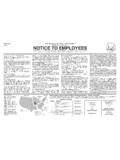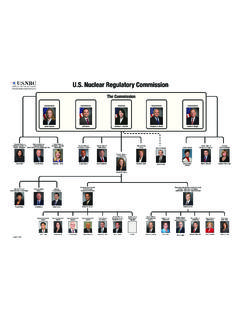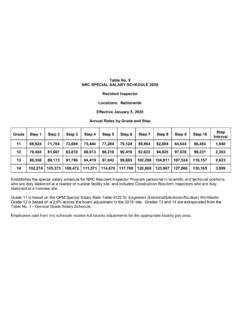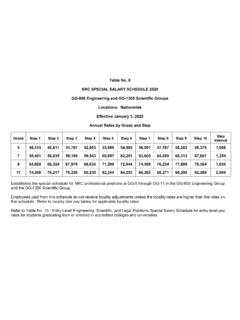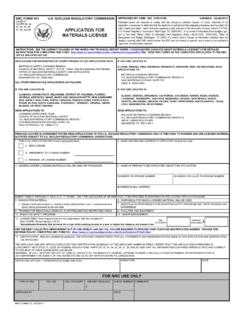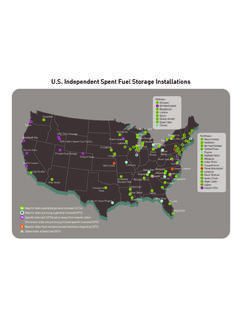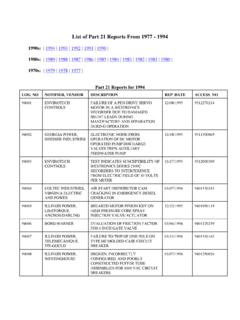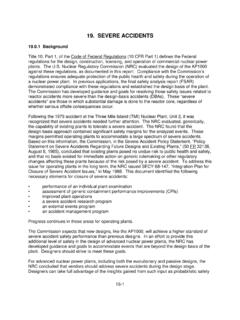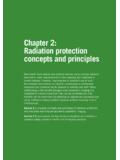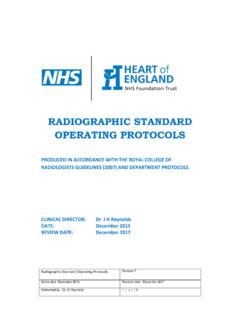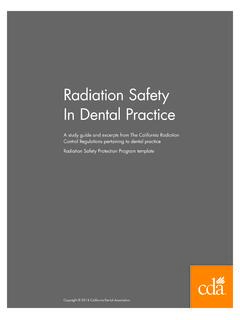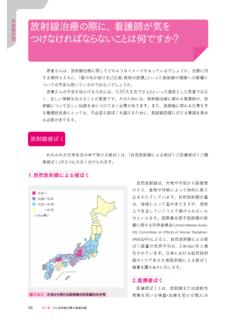Transcription of Radiation Protection Standards & Guides
1 Chapter 3: Radiation Protection Standards & GuidesSART Chapter 3 - RadProtection Standards & GuidesObjectives: Describe regulations governing occupational Radiation exposure to personnel and minors, or dose limits to members of the general public. State the meaning of DDE, EDE, CDE, Wt, CEDE, SDE, TEDE, and TODE. Explain the requirements for Planned Special Exposures and associated annual and lifetime dose limits. Discuss the requirement to keep occupational Radiation exposure As Low As reasonably achievable (ALARA).2 SART Chapter 3 - RadProtection Standards & GuidesObjectives: Describe exposure control areas, corresponding warning signs and state the permissible Radiation /radioactivity levels for Radiation area, high Radiation area, very high Radiation area, airborne radioactivity area, and radioactive materials area.
2 Discuss recommendations concerning emergency exposure. Discuss regulations governing prenatal Radiation exposure. Identify the purpose of NRC Forms 3, 4, & Chapter 3 - Rad Protection Standards & GuidesDose Limit RequirementsThe occupational dose limits are established in 10 CFR Part 20 for NRC licensees. The occupational dose limits for NRC employees are established in Management Directive The limits in this document are comparable to those in 10 CFR Part Chapter 3 - Rad Protection Standards & GuidesRad Standards for workers are expressed as whole-body dose equivalents. In reality, the body is rarely uniformly irradiated; certain parts of the body/organs are often more affected than others. This is because activity taken into the body is distributed unequally among organs ( , radioactive iodine concentrates in the thyroid, inhaled plutonium mainly affects the lungs, and strontium goes to in bones).
3 In addition, it is possible that only a portion of the body might be exposed to an external Radiation source. Dose Limits - General5 SART Chapter 3 - Rad Protection Standards & GuidesDose Limits - Organs Organ Dose Limits - objective is avoid harm to organs (deterministic) that would impair their function. Total Dose = External Dose + Internal Dose External - dose at 1 cm depth in tissue, called the DEEP DOSE EQUIVALENT (DDE). Internal dose from internally-deposited radionuclides is called the COMMITTED DOSE EQUIVALENT. The CDE is determined for a 50-year interval and assigned to the year of Chapter 3 - Rad Protection Standards & GuidesThe Committed Dose ConceptThe dose from internally deposited radionuclides is based on the Committed Dose concept. This concept assigns the dose over a 50 year interval to the year of intake.
4 For a short lived radionuclide, such as I-131 with an 8 day half-life, most likely all the dose will actually be received during the year of intake. For other radionuclides, such as Am-241 with a half-life of about 432 years, there may be dose received even after the 50 year interval. Years after Intake50 Activity as Function of Time17 SART Chapter 3 - Rad Protection Standards & GuidesDose Limits - Organs Total Organ Dose Equivalent (TODE) limit is 50 rem per year to organs of the body from internal and external exposure (at a depth of 1 cm in tissue). TODE = DDE + CDE TODE 50 rem in a year8 SART Chapter 3 - Rad Protection Standards & GuidesDose Limits - Whole Body Total Effective Dose Equivalent (TEDE) limit is 5 remper year to the whole body from internal and external exposure (at a depth of 1 cm in tissue).
5 TEDE = EDEX + CEDE CEDE = CDE x WT WTis the weighting factor that relates the risk of dose to an individual organ to risk of dose to the whole Chapter 3 - Rad Protection Standards & GuidesDose Limits - Whole Body 10 CFR20 defines TEDE as the sum of the effective dose equivalent (for external exposures) and the committed effective dose equivalent (CEDE) (for internal exposures). However, EDEX cannot be directly measured. Use of DDE generally provides a conservative and best estimate of EDEX. In non-uniform fields ( , directional source), DDE can be overly conservative. Use of an approved method ( , 2-dosimeter) to calculate EDEX is allowed per RG Part 20 also says that DDE be measured at the part of the body with the highest Chapter 3 - RadProtection Standards & GuidesWeightingFactors (WT)for OrgansOrgan/TissueWT*Gonads bone ** multiplier used to determine effective dose from equivalent dose in one/more organs/tissues.
6 The factor takes account of the sensitivities of different organs/ tissues for induction of stochastic effects from exposure to ionizing Radiation (principally induction of cancer). 11*From ICRP 26**Five highest organsSART Chapter 3 - Rad Protection Standards & GuidesExtremities -elbows and arms below elbowsknees and legs below kneesWhole Body -everything except extremitiesSkin, Extremities& Whole BodySkin of the Whole Body -skin covering everything except the extremities12 SART Chapter 3 - Rad Protection Standards & GuidesDose Limits - Special Limits Lens Dose Equivalent (LDE) - 15 rem per year to the lens of the eye from external Radiation (measured as cm depth in tissue). Shallow Dose Equivalent (SDE) -50 rem per year ( cm depth in tissue) to skin of the whole body or to the extremities (SDEME, SDESKIN) averaged over 10 Chapter 3 - Rad Protection Standards & GuidesOccupational Dose Limits -Minors The ANNUAL occupational dose limits for minorsis 1/10thof the adult occupational dose limit: TODE 5 rem TEDE rem LDE rem SDE 5 rem14 SART Chapter 3 - Rad Protection Standards & GuidesDose Limits Members of the Public The dose limits to members of the public (excluding dose from background Radiation and medical exposure) are: 100 mrem TEDE in a year; and 2 mrem in any one hourin an unrestricted area from external are other public limits out there for EPA, etc.
7 That are different. For example:40 CFR190: 25 mr/yr15 SART Chapter 3 - Rad Protection Standards & Guides If the dose rate is 12 mrem/hr, but the source is only exposed for 10 minutes, the dose in any one hourwould be:(12 mrem/hr)(1 hr/60 min)(10 min) = 2 mrem The dose ratein this example is up to 12 mrem/hr. However, the time that the source is used which could result in a dose to the public is limited so that in any one hour the public dose would not exceed 2 Limits Members of the Public16 SART Chapter 3 - Rad Protection Standards & GuidesPlanned Special Exposures (PSEs) In addition to the annual adult occupational limits, planned special exposure (PSE) limits are established to allow additional dose in special situations. PSE s are doses that are in addition toannual occupational dose. The licensee must comply with the provisions of a PSE: Must be a special situation with written plan in advance of the work Must not be routine work Person involved must be informed about radiological conditions & ways to maintain dose as low as reasonably achievable (ALARA) Person must have their complete dose history Must maintain records Must inform people involved of their dose within 30 days Must notify the NRC regional office Doses must not exceed PSE dose Chapter 3 - Rad Protection Standards & GuidesPlanned Special Exposures (PSEs)PSE dose limits are: Equal to annual occupational dose limits in any year.
8 & Not to exceed 5X the annual limits in person s rem5 rem25 remTODE50 rem50 rem250 remLDE15 rem15 rem75 remSDE50 rem50 rem250 remSee Regulatory Guide for more information on Chapter 3 - Rad Protection Standards & GuidesDose History Dose is reported to worker if it exceeds 100 mremTEDE or 100 mremto any individual organ/tissue, or if it is requested ( ). NRC Form 4 is Cumulative Occupational Dose History you will find the terms you ve learned in this chapter when you receive one of these reports, , DDE, CDE, CEDE, LDE, SDE, TEDE, TODE. Note that these records include PSE doses as well as routine annual occupational dose information. NRC Form 5 is Occupational Dose Record for a Monitoring Period. Typically a monitoring period is a year. It could be less if you were at a site and used dosimetryfrom the site.
9 It has the same alphabet soup terminology above, plus some additional terms the intake, class and Chapter 3 - Rad Protection Standards & GuidesSigns and PostingThe licensee shall post the area with a conspicuous sign or signs bearing the Radiation symbol and the words: Radiation Area > 5 mrem/hour @ 30 cm (from the source or any surface that it penetrates): CAUTION, Radiation AREA. High Radiation Area > 100 mrem/hour @ 30 cm: CAUTION, HIGH Radiation AREA or DANGER, HIGH Radiation AREA. Locked High Radiation Area, > 1,000 mrem/hr; this is a Technical Specification designation. Very High Radiation Area > 500 rads/hour @ 1 m: GRAVE DANGER, VERY HIGH Radiation AREA. 20 SART Chapter 3 - Rad Protection Standards & GuidesHigh and Very High Radiation Areas Access to High Radiation Areas and Very High Radiation Areas is required to be controlled.
10 The controls must either: (1) limit the dose rate to less than 100 mrem/hr; (2) provide a conspicuous visible or audible alarm so that the person entering the area and the supervisor of the operation are aware of the entry; or (3) entry ways are locked with positive access control over each individual entry. Inadvertent or unauthorized access to Very High Radiation Areas is to be prohibited by licensee-instituted Chapter 3 - Rad Protection Standards & GuidesSigns and Posting Radioactive Material Area where more than 10 times the activity in 10 CFR 20 Appendix C is stored, CAUTION, RADIOACTIVE MATERIAL(S), or DANGER, RADIOACTIVE MATERIAL(S). 22 SART Chapter 3 - Rad Protection Standards & GuidesSigns and Posting Airborne Radioactivity Area the airborne concentration is more than 1 DAC or, where an individual present without respiratory Protection equipment could exceed, during the hours an individual is present in a week, an intake of ALI or 12 DAC-hours (30% of a DAC): CAUTION, AIRBORNE RADIOACTIVITY AREA or DANGER, AIRBORNE RADIOACTIVITY AREA.
